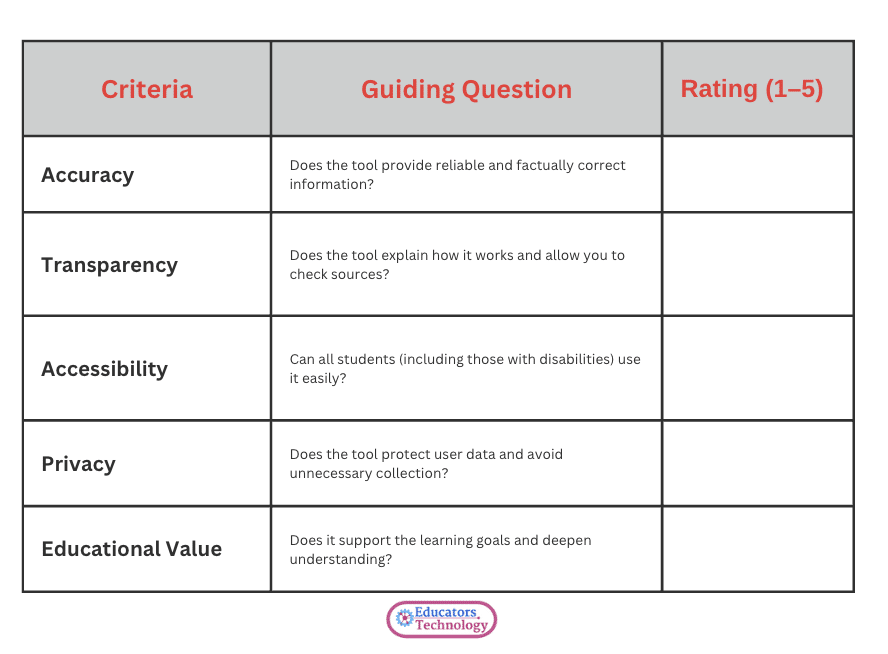This year, AI will have a place in your classroom. In the North American context, almost every school district is now encouraging some form of AI integration. I know some of you are still concerned about the impact of AI, but I’ve moved past that debate. What matters now is clear: developing your AI pedagogy and building your AI literacy. Period.
Over the past months, I’ve been sharing resources to help teachers take practical steps in this direction.
Practical AI Tips for Teachers
Today, I’m adding another one to the list, a resource full of concrete tips to keep in mind as you prepare for the new school year. From creating a classroom AI policy with your students, to modeling responsible use, to making sure accessibility is front and center, these strategies are designed to make AI a tool for deeper learning rather than distraction.
1. Develop your AI pedagogy
Before diving into tools, think about your approach. Ground your use of AI in sound pedagogy and theory, not just convenience.
Ask:
- How does this align with my teaching goals?
- How does it support critical thinking, creativity, or inclusion?
- Does this use of AI deepen student understanding, or just make tasks quicker?
- Will it encourage students to think more critically, or risk making them passive?
- How does it connect to the curriculum standards or learning outcomes I’m targeting?
- Could this tool unintentionally introduce bias or misinformation into the learning process?
- Am I modeling ethical and transparent use when I integrate AI into my teaching?
- Does this create opportunities for student voice, choice, and creativity?
- How will I assess the effectiveness of AI in supporting learning?
- What scaffolds or supports will students need to use this tool responsibly and productively?
This mindset helps you avoid chasing trends and instead use AI intentionally.
2. Create a classroom AI use Policy with Students
Invite your students to co-create an AI use policy. Framing it as a shared agreement makes it more meaningful and encourages ownership. Define the purpose, scope, and expectations together.
- Here are some questions that you and your students can use to shape this shared agreement:
- What purposes should AI serve in our classroom — research, brainstorming, practice, or something else?
- Which types of assignments or tasks should AI be allowed for, and which should remain AI-free?
- How should students give credit or cite AI when they use it to support their work?
- What responsibilities do we have when checking the accuracy and fairness of AI outputs?
- How can we ensure AI use respects privacy, safety, and ethical boundaries?
- What are the expectations if someone misuses AI or goes against the agreed policy?
- How can we keep AI use equitable so that all students have fair access and support?
- How will we revisit and update this policy as we learn more about AI and how it fits into our class?
Related: AI Classroom Policy Guide for Teachers
3. Discuss Assignment Guidelines for AI
Clarify which assignments AI can be used for, and how. The AI Assignment Scale by Perkins, Roe, and Furze (2024) is a useful reference here.
4. Pick the Chatbot of Your Choice and Customize
Choose a main AI assistant you’re comfortable with: ChatGPT, Claude, Gemini, or another tool. Then adjust its settings to reflect your teaching context: tone, complexity of explanations, or even multilingual support. This way, the AI becomes tuned to your classroom needs instead of being a generic tool.
5. Create a Rubric for Evaluating AI Tools
Not all AI tools are created equal. Develop a rubric with criteria such as accuracy, transparency, accessibility, and privacy. Share it with students so they can also evaluate tools critically. Having a consistent framework prevents you from adopting flashy apps that may not actually support learning.

6. Communicate with Parents
Parents need to know what AI is doing in your classroom. Share your AI use policy and explain how it enhances student learning. Many parents may have concerns or misconceptions, proactive communication builds trust and demonstrates your commitment to responsible use.
7. Explain Ethical and Safety Implications
Set time aside to discuss the ethical dimensions of AI. Talk about bias, privacy, plagiarism, and how AI outputs should always be reviewed with a critical eye. This positions AI as something students need to think about, not just consume.
8. Define Consequences Clearly
Make sure students understand what happens if they go against your AI policy or academic integrity guidelines. Consequences should be clear, consistent, and fair. When expectations are transparent, students are more likely to respect the boundaries.
Example: ““If AI is used in ways we didn’t agree on, the work won’t count and you’ll need to redo it. If it happens again, school rules on academic integrity will apply.””
9. Avoid Policing AI Use
Over-policing can backfire. Heavy surveillance creates an atmosphere of mistrust. Instead, focus on guiding students toward responsible, ethical practices. Building a culture of trust leads to healthier long-term learning habits.
10. Prioritize Accessibility
Ensure that AI tools are accessible to all learners, including those with disabilities or limited internet access. If certain tools fall short, find or create alternative pathways. Equity should guide every AI decision you make.
11. Model Responsible AI Use
Students learn best by seeing their teachers in action. Show them how you use AI responsibly — checking sources, citing outputs, and using it as a thought partner rather than a shortcut. Modeling sets the standard more effectively than rules alone.
12. Keep human Connections Central
AI can assist, but it can’t replace the human bond between teacher and student. Prioritize empathy, mentorship, and relationships. A strong rapport with your students is the foundation of all effective teaching — and no algorithm can replicate that.
13. Invest in Professional Development
Dedicate time to developing your own AI literacy. Explore guides, online PD sessions, or webinars tailored for educators. The more confident you are in using AI, the better you’ll be at supporting your students.
Here is a list of some highly recommended and free AI guides to help you develop your AI literacy.
14. Reflect and Adjust
Regularly reflect on your own use of AI in teaching. What worked? What fell flat? Adjust your strategies based on classroom realities and student feedback. Treat AI integration as an iterative process, not a one-time decision.
15. Learn with Colleagues
AI integration doesn’t need to be a solo journey. Share experiences with colleagues, exchange strategies, and discuss what’s working in different classrooms. Professional communities and conferences are great spaces to sharpen your practice.
Here a downloadable PDF version of this guide:





